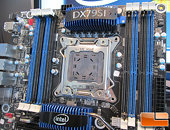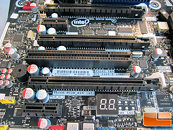- Joined
- Oct 9, 2007
- Messages
- 47,454 (7.50/day)
- Location
- Hyderabad, India
| System Name | RBMK-1000 |
|---|---|
| Processor | AMD Ryzen 7 5700G |
| Motherboard | ASUS ROG Strix B450-E Gaming |
| Cooling | DeepCool Gammax L240 V2 |
| Memory | 2x 8GB G.Skill Sniper X |
| Video Card(s) | Palit GeForce RTX 2080 SUPER GameRock |
| Storage | Western Digital Black NVMe 512GB |
| Display(s) | BenQ 1440p 60 Hz 27-inch |
| Case | Corsair Carbide 100R |
| Audio Device(s) | ASUS SupremeFX S1220A |
| Power Supply | Cooler Master MWE Gold 650W |
| Mouse | ASUS ROG Strix Impact |
| Keyboard | Gamdias Hermes E2 |
| Software | Windows 11 Pro |
Here are the first pictures of Intel Desktop Board Extreme Series DX79SI. This is the first socket LGA2011 we've seen that has eight DDR3 DIMM slots (four on either side of the socket, two DIMMs per channel), every other board has barely enough room for four. LGA2011 supports quad-channel DDR3 memory, yielding 33% bandwidth gain over triple-channel DDR3 and 100% gain over dual-channel DDR3. Despite its large memory area, the DX79SI sticks to standard ATX board dimensions. This is thanks to some smart engineering.
While on other LGA2011 boards, the CPU VRM is concentrated to the north of the socket, on this board, it is split between the north and south of the socket. Both areas have heatsinks, and the VRM area to the south is located where older generations of motherboards would typically have the northbridge chip. X79 is a single-chip chipset, located where the PCH/southbridge typically is.



Expansion slots on the board include three PCI-Express 3.0 x16. The topmost slot is electrical x16, the second one is electrical x16 (which switches down to x8 if the third slot is populated), and the third one of course is electrical x8, that takes 8 lanes from the second slot. Other slots include two PCIe 3.0 x1 (bandwidth comparable to PCI 1.1 x4), and one legacy PCI.
The board seems to be using Patsburg-A variant of the X79 chipset, which lacks SAS ports and the supplementary 8 GB/s link to the processor, it relies on the DMI link (4 GB/s), and gives out only SATA ports. There are two SATA 6 Gb/s ports, and two SATA 3 Gb/s ports internally, with no additional ports as eSATA on the rear panel.


Sandy Bridge-E lacks integrated graphics, and so there are no display outputs. There's 8-channel HD audio with TOSLINK digital output, two gigabit Ethernet connections (one driven by an Intel controller, and another by a Realtek-made one), two USB 3.0 ports, FireWire, and a number of USB 2.0 ports.
View at TechPowerUp Main Site
While on other LGA2011 boards, the CPU VRM is concentrated to the north of the socket, on this board, it is split between the north and south of the socket. Both areas have heatsinks, and the VRM area to the south is located where older generations of motherboards would typically have the northbridge chip. X79 is a single-chip chipset, located where the PCH/southbridge typically is.



Expansion slots on the board include three PCI-Express 3.0 x16. The topmost slot is electrical x16, the second one is electrical x16 (which switches down to x8 if the third slot is populated), and the third one of course is electrical x8, that takes 8 lanes from the second slot. Other slots include two PCIe 3.0 x1 (bandwidth comparable to PCI 1.1 x4), and one legacy PCI.
The board seems to be using Patsburg-A variant of the X79 chipset, which lacks SAS ports and the supplementary 8 GB/s link to the processor, it relies on the DMI link (4 GB/s), and gives out only SATA ports. There are two SATA 6 Gb/s ports, and two SATA 3 Gb/s ports internally, with no additional ports as eSATA on the rear panel.


Sandy Bridge-E lacks integrated graphics, and so there are no display outputs. There's 8-channel HD audio with TOSLINK digital output, two gigabit Ethernet connections (one driven by an Intel controller, and another by a Realtek-made one), two USB 3.0 ports, FireWire, and a number of USB 2.0 ports.
View at TechPowerUp Main Site








 this thing just begs to be shown off
this thing just begs to be shown off
